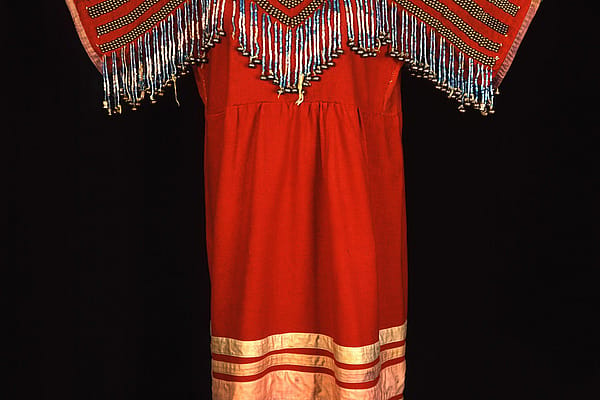
Indian Relay: America’s First Extreme Sport
Competition runs through the blood of Native American men and women. The insatiable need to push one’s body to athletic perfection is exemplified in the sport of Indian Relay. Indian Relay combines horsemanship, athleticism, and tribal competition—which sets the course for an exhilarating experience for both rider and spectator.

©Chris Douglas Photography
Indian relay originates approximately 400 years ago when the sacred horse was introduced to the Plains. Native men and women forged unprecedented relationships with the animal. The symbiotic relationship between Plains tribes and horses was instantaneous. Horses made activities such as travel, hunting, and war easier. Tasks otherwise accomplished on foot or with the help of domesticated dogs was increased with the use of horses. Horses were not seen merely as an utility but a gift from First Creator. The image of the sacred animal was adopted in everyday clothing. Men and women also made objects to honor their horses during times of war, celebration, and the movement of camps. Horses were adorned in feathers, horse masks, and ceremonial amulets for protection. This tradition is carried on in relay with men adorned in traditional breach cloths, feather bonnets, eagle feathers, and painted symbols on their thoroughbreds.
Indian relay has varying origins among Plains tribes. Some tribes believe that relay was “used as war games, to another a relay to hunt the buffalo, to another a way to outrun the wild horses to enable their capture.”[1] Today’s Indian Relay competition is an organized sport with governing associations, rules, and prize money. Races are broken into heats, with 4-6 teams lined up on a race track. Each team has three race horses, one relay rider, two horse holders, and a horse mugger. The mugger is responsible for catching incoming horses in between exchanges, while the holders calm the horses before and after runs.
A gun is fired and a relay rider mounts his first horse bareback, running full speed around a half mile track. The rider completes his first lap and gallops into his starting position to mount his second horse. A third and final exchange happens before the race is completed. The heat winner is the first rider to cross the finish line without penalty. Penalties include failure to pay racing fees, loose horses on the track (rider falls off or mugger fails to catch horse), false starts, rider dismounts in another team’s area, and striking another team’s horse.
Throughout Indian Country, over 50 teams compete for the coveted title of “Indian Relay National Champion.” Owners, riders, and trainers work year round to perfect their techniques. Indian relay can be observed at cultural events such as the Annual North American Indian Days Celebration, Calgary Stampede, Sheridan Wyo Rodeo, Annual Shoshone-Bannock Festival, Annual Crow Fair, and the All Nations Indian Relay Championship.
*Special thank you to Chris Douglas Photography for his Indian Relay photographs.
[1] “About Indian Relay,” http://www.professionalindianhorseracingassociation.com/about-indian-relay/ Accessed 7/6/17.
Written By
Hunter Old Elk
Hunter Old Elk (Crow & Yakama) of the Plains Indian Museum at the Buffalo Bill Center of the West, grew up on the Crow Indian Reservation in Southeastern Montana. Old Elk earned a bachelor's degree in art with a focus on Native American history at Mount St. Mary’s University in Maryland. Old Elk uses museum engagement through object curation, exhibition development, social media, and education to explore the complexities of historic and contemporary Indigenous culture. She is especially inspired by the stories of Native American women who lived and thrived on the Plains. Facebook/ Instagram: @plainsindianmuseum













